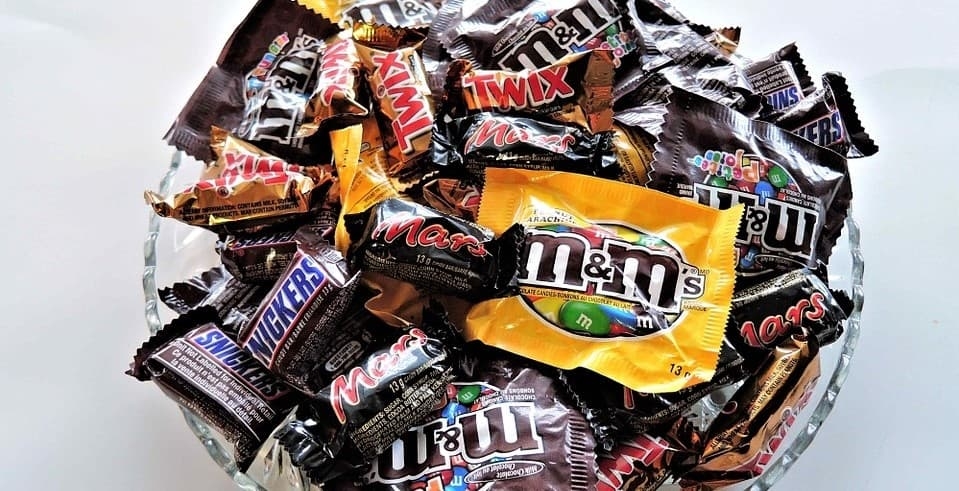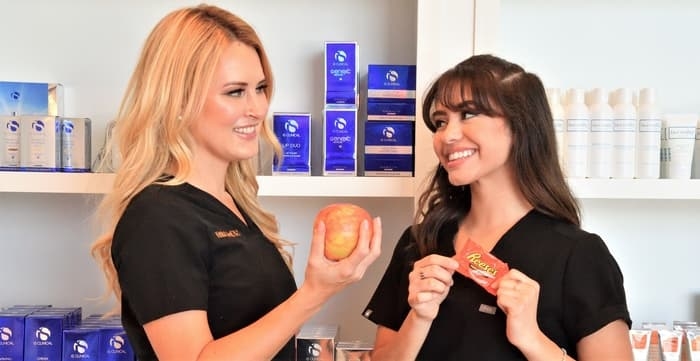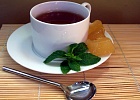
Duplicity is a Latin word meaning twofold or containing a double meaning. And over the years, through its English translation, it has picked up a deceptive aspect to its meaning, as when a person acts one way to hide or cover an opposite, more authentic nature.
Sugar is duplicitous.
One side of sugar is perfect. Sugar is essential to life. Without it . . . our cells cannot survive. Chemically, all carbohydrates contain sugar, and our bodies use carbohydrates as fuel. Our brain needs sugar, as does the rest of our body. So, in proper amounts, in an appropriate form, sugar is good.
But sugar also has a different side, a much more devious side, . . . a more insidious side.
 Food manufacturers well understand that ingesting too much sugar can set off a chain reaction of adverse effects. Indeed, if you seek a sure-fire way to look older—simply overconsume sugar!
Food manufacturers well understand that ingesting too much sugar can set off a chain reaction of adverse effects. Indeed, if you seek a sure-fire way to look older—simply overconsume sugar!
Which is why, at last count, food manufacturers have found over sixty words to describe it. From the more apparent descriptions—sugar, brown sugar, beet sugar, coconut sugar, cane sugar, and high fructose corn syrup, to the much more intentionally deceptive—agave nectar, molasses, and my two favorites . . . barley malt and turbinado, sugar is a master of disguise.
Ok, so essentially, this seems to be the message—take in some sugar but not too much. Sounds reasonable and straightforward. But like so much in life . . . easier said than done.
In the United States, sugar is darn near impossible to avoid. From soda and mocha lattes to doughnuts and sticky buns . . . sugar is the main ingredient.
And what exactly happens when we take a bite of that favorite cookie of ours?
When we consume sugar, our body is brilliantly designed to release a hormone from our pancreas called insulin. Insulin is used to assist the body with energy conversion. When you consume glucose in the form of carbohydrates, it becomes energy for your cells. When too much sugar is consumed, however, an abundance of energy is created, and that extra energy is then stored in the liver.
On first blush, that does not sound too bad. But if day after day, insulin is released at abnormally high levels—then the insulin supply from the pancreas will eventually become exhausted or not as potent, and too often that leads to weight gain, insulin resistance, and/or diabetes.
When insulin resistance occurs, excess sugar is found floating around our bloodstream, and little sugar molecules start to make tiny cuts throughout our bodies. Eventually, we see damage in the kidneys, eyes, skin, vessels of the heart, and nerves. In the skin, glycation can be observed with the naked eye as the excess sugar attaches to the collagen and elastin proteins reduce the skin’s elasticity, firmness, and glow. In fact, one of the fastest ways to achieve vibrant skin is to eliminate excess sugar consumption in your diet.
Here are a few of my favorite ways to reduce your sugar intake throughout the holidays.

1. Intermittent Fasting
When you allow your body to rest instead of digest, you allow your energy to be used for cellular repair and renewal, healthy hormone manufacturing, and unhealthy DNA scavenging. Start with fasting for 12 hours a day, and if this feels comfortable, slowly move to a daily goal of 16-18 hours of fasting. For example: try to finish your dinner by 6:30 p.m. and then avoid eating anything again until 10:30 a.m. the next day. Water, unsweetened tea, and unsweetened coffee doesn’t count, and water is encouraged during fasting hours to maintain hydration and get juices moving as you wake up.
2. Enjoy Whole Foods.
When we eat food in its natural state, we naturally consume less sugar and reduce sugar cravings. So, skip the blueberry muffin and grab a carton of blueberries for breakfast!
3. Avoid high fructose corn syrup at all costs.
High fructose corn syrup is found in a lot of our processed foods, especially candy. It is a sugar substitute that is difficult for the liver to process and creates blood sugar spikes that increase appetite.
4. Keep treats for special occasions.
Try not to reward yourself or your kids with sugary treats unless it’s a part of a big celebration. Kids love being "in charge," so instead of taking them out for ice cream when they get an A on their test, let them plan the Saturday family outing or chose the movie for movie night.
5. Let your kids trade Halloween candy in for a toy or cash.
The candy hunt is rewarding, but the year supply of candy that comes with it can create behavioral changes, cavities, and unhealthy blood sugar spikes. Candy donations to our troops is an alternative way to say thank you to those who serve. Try Soldier Angels or Operation Gratitude.
6. Exercise.
Exercising for 30minutes a day is a great way to stabilize your blood sugar, release growth hormone and reduce cravings for sugary treats. Try exercising first thing in the morning on an empty stomach for an extra boost!'

Sugar is a treat, for sure. But over time, when consumed in excess, it will create internal and external havoc. Get your holiday glow from within by reducing sugar intake and be creative with rewards!
Remember, it is important to have your bloodwork done at least annually. Always consult with your family physician before starting a new diet or exercise program, especially if you are diabetic, hypoglycemic, or insulin resistant.
Kristina Cadwell, M.S., PA-C, founder and CEO of Vibrant Skin Bar & Vibrant Vitality Clinic in Arcadia, is a wellness leader with more than 17 years in family practice and medical aesthetics. She also is a certified instructor in a myriad of treatments, delivering aesthetic and wellness care through comprehensive diet and healthy living practices that result in vibrant skin.
Vibrant Skin Bar
(480) 422-2058























